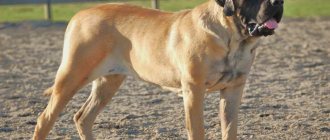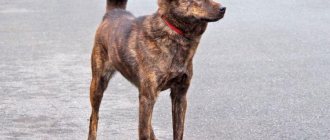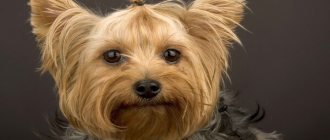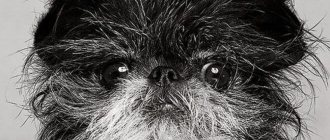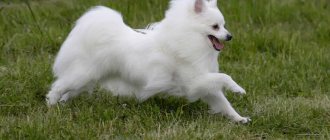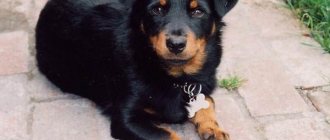a brief description of
- Other names: Pyrenean Mastiff, Mastin del Pirineo, Pyrenean Mastino, Pyrenean;
- Height: from 81 cm, no upper limit;
- Weight: up to 86 kg;
- Color: white, on the face there is a dark, clearly defined mask, spots on the body with clearly defined contours of the color of the mask are black or brown;
- Coat: thick, coarse, medium length, not fluffy, with dense undercoat;
- Lifespan : 10-12 years;
- Advantages of the breed: Beneath its terrifying appearance lies a gentle and devoted friend, companion, educator and passionate participant in all children's games. Aggression towards a person manifests itself only if there is a real threat to the life of the owner and his environment. Despite its enormous size, the dog's appetite is more than moderate.
- Difficulties: Monogamous dogs that practically do not survive a change of owner.
- Price: $1500.
Pyrenean Mastiff Appearance Standards
The requirements for the appearance and character of Pyrenean mastiffs have changed several times. The current standard was recognized on May 26, 1982. According to this document, in order for a dog to receive a breed certificate, it must meet the following requirements:
- Height at withers: males - 77–81 cm, females at least 72–75 cm.
- This breed is one of the largest dogs in the world
- Weight: 70–80 kg.
- The dog is large, above average height, strong, muscular
- The head is large. The width of the muzzle at the nose should not differ noticeably from the width of the muzzle at the base. The occipital part is massive, slightly convex. The teeth have a scissor bite. The eyes are dark and small. The nose is fleshy. The ears are hanging, thin, tapering towards the tip.
- In the Pyrenean Mastiff, the transition from the forehead to the muzzle is weak, not accentuated, but visible
- The body is strong. The neck is thick, but small, the shoulders are wide, and the croup, on the contrary, is narrowed. The back is straight, without significant deflections. The chest is dense, the ribs are widely spaced. The stomach is slightly tucked.
- The Pyrenean Mastiff has a strong body and can even carry an adult human.
- The limbs should be straight, with the paws pointing forward. The forearms are three times longer than the metacarpus. The hock joints are directed vertically.
- The Mastiff's limbs should provide a strong thrust without the slightest difficulty, and the large soft pads ensure that these large dogs move silently
- The tail is long and set quite high. When at rest, it hangs down and easily reaches the hock joints; when moving, the dog tenses its tail and pulls it back with a saber.
Pyrenean Mastiffs are fluffy dogs. They have thick and long hair on all parts of the body. Two-tone coloring is preferred. The spots should be contrasting. Being tri-colored is not a reason for culling, but it is not highly valued, so puppies with this color will cost less. Single color (pure white, black, brown) is considered an elite trait, as it is difficult to maintain when breeding.
Proportions
The length of the body is not much greater than the height at the withers, and the width of the chest can reach half of the height. The sternum itself does not fall below the level of the elbow. The tail is set moderately high, thick at the base, mobile, and ends in a fluffy tassel of wool.
Color variations
The color of the coat of the Pyrenean Mastiffs gives them an external resemblance to St. Bernards.
The coat is always white, there is a mask of brown, black, yellow or gray on the face, and spots on the body that match the mask.
The most preferred colors include white with grey, yellow, brown, silver grey, black, light beige, merle or sand markings.
Solid white or tri-colored coats are not acceptable according to the breed standard.
The lower third of the limbs and the tip of the tail are always white.
Reasons for disqualification
Disqualifying faults include being too frail. A true Pyrenean Mastiff must be a strong dog. Dogs with:
- strong arch in the lower back;
- shortened tail;
- thin, curly hair;
- the presence of bald patches;
- narrow head and too long muzzle;
- bifurcated nose;
- severe underbite or overbite.
There are discquals based on character. For Pyrenean Mastiffs, cowardice and excessive aggression are unacceptable.
Spotted Mastiffs will be rejected if they do not have a "mask" pattern on their face and their spots are not clearly defined.
Origin story
The Pyrenean Mastiff, although the Spaniards themselves call the dogs Mastino, is such an ancient breed that we can safely say that the ancestors of these huge and graceful animals accompanied the ancient Phoenicians on their endless campaigns. Dogs were bred for the sole purpose of obtaining a powerful and hardy dog for long journeys of flocks and, in addition, for the dog to protect sheep from attacks by wolves, and humans from bears, which were found in abundance in the Pyrenees. The appearance of the dogs was not considered a priority , the main thing was that the individuals ended up being large.
Depending on the region of residence, a type was formed that was characteristic only of a certain area. Regional dogs were not crossed with each other, giving preference to the material that was “at hand.” As a result of natural selection, today in Spain there are two popular breeds - the Spanish and the Pyrenean mastiff with a common ancestor - the Pyrenean mountain dog - and colossal external differences.
At the end of the 19th century, the Pyrenees were also represented at the Madrid Cynological Exhibition of dogs of all breeds. Representatives of the breed instantly reached heights of popularity , especially in the circles of nobles - owners of local lands. And for puppies of the Pyrenean Mastiff breed the price was set at the size of a fortune, not everyone can afford it. But this period was short-lived, as World War II broke out.
Post-war Spain was consumed by crisis in both the political and economic spheres. Large dogs are simply no longer needed by anyone. First, the total number of livestock decreased, and following the reduction of flocks, wolves disappeared from Spanish territory. The Pyrenean Mastiff is on the verge of extinction . And if it were not for Andrés García Jaime, president of the Aragonese Kennel Club, this breed would have been lost forever.
In the mid-70s of the last century, the Pyrenees were again presented to the expert commission, causing genuine delight not only among dog handlers, but also among the guests present. The breed was recognized and certified. But the most interesting thing is that from that moment on, packs of wolves appeared again in the Pyrenees, and the demand for the Pyrenees increased again.
How the breed appeared
The ancestors of the breed are Tibetan Molossians. In the 17th century, puppies were brought from Asia to Spain, where shepherds liked them. It turned out that dogs are ideally suited for protecting sheep from thieves and large predators. Due to the fact that the Molossians of different regions of the country did not intersect, their tribal characteristics gradually began to stand out. In the north and northeast, the Spanish Mastiff breed emerged. The southern mountainous regions are home to the fluffier, stockier Pyrenean Mastiff.
The main task of the Pyrenean mastiffs for many centuries remained the protection of sheep herds from thieves, wolves, bears and other large predators.
For a long time, dogs were considered exclusively working dogs. They were supported by simple peasants. It was only in the 1890s that people seriously involved in dog breeding became interested in the breed. In 1896, three Pyrenean mastiffs were presented for the first time at a canine exhibition. The first nursery was opened in 1946. In 1954, the Pyrenean Mastiffs were recognized by The Federation Cynologique Internationale (in the list of breeds, the dogs appear at number 92 in group No. 2, section No. 2, subsection No. 2.2 “Molossians: mountain dogs”). In 1977, Mastiffs were recognized by the Royal Society of Canine Sciences of Spain (RSCE).
These dogs are characterized by great height and a large head with a wide skull, well-developed bones and powerful muscles.
Purpose of the breed
Possessing a cheerful and affectionate character , the Pyrenean Mastiff can instill genuine terror in a person unfamiliar with the breed just by its appearance . The character of a dog can only be learned through direct communication with it.
In the Middle Ages, Pyrenees were bred not only to protect estates and sheep flocks. Large animals were used as military dogs . Each of them accompanied the owner-warrior going into battle with the enemy. During the reign of Louis XIV, the Louvre was guarded by Pyrenean mastiffs brought as a gift to the emperor from Spain.
The Pyrenees were never used for hunting , despite their extreme endurance on long journeys. Intelligence, balance and a friendly attitude towards other representatives of the animal world did not allow the Pyrenean Mastiff to become a hunter, unlike other herding breeds.
And today, the Pyrenees are used for their intended purpose - they help drovers move herds and protect them from gray predators . Recently, in many European Union countries, dogs have begun to be used as bodyguards . The popularity of the breed has also increased, occupying the second place in the ranking of the largest dogs on the planet after the bullmastiff.
Reasons for disqualification
Disqualifying faults include being too frail. A true Pyrenean Mastiff must be a strong dog. Dogs with:
- strong arch in the lower back;
- shortened tail;
- thin, curly hair;
- the presence of bald patches;
- narrow head and too long muzzle;
- bifurcated nose;
- severe underbite or overbite.
There are discquals based on character. For Pyrenean Mastiffs, cowardice and excessive aggression are unacceptable.
Spotted Mastiffs will be rejected if they do not have a "mask" pattern on their face and their spots are not clearly defined.
Character
The appearance of the huge Spanish shepherd and part-time security guard is quite impressive. People have mixed feelings about large dogs, but many know that the Pyrenees is peaceful and affectionate . Dogs carefully take care of their master's children and are endlessly devoted to their owner.
The Pyrenean Mastiff is very friendly towards dogs of other breeds and animals living with them. Pyrenean Mastiffs are a pack breed. If the owner is not endowed with the quality of a leader and leads a passive lifestyle, the Pyrenean is unlikely to listen to his commands.
Did you know? A peculiarity of the Pyrenean Mastiff is the need to develop in the character of a friendly dog a sense of suspicion towards strangers.
Character of the Tibetan Mastiff
Tibetans have a very interesting character: bright, expressive, unusually harmonious and friendly.
The Tibetan Mastiff is a dog that has never been seen wandering. Experts figuratively compare the voice of a Tibetan mastiff to the blow of a copper gong: dull and deep. In China, the special velvety “timbre” of the Tibetan voice was highly valued, for which they were even specially given heated milk to drink!
The Tibetan Mastiff rarely gives a voice, never bursts into senseless barking to scare any passerby, because this dog can stand up for itself and its loved ones without it. In addition, she is able to make decisions on her own - when the owner is not in danger, and only a guest has come, she will calmly step aside, but if a person tries to enter the house with bad intentions, she will protect you.
This happens because the Tibetan mastiff has an unusually developed sense of smell and intelligence. Tibetan Mastiffs have tan (golden brown) spots above the eyes. Tibetan sages say that such a dog never sleeps and, as it were, looks at the world with four eyes - its “second pair” of eyes are constantly open. Indeed, Tibetans very sensitively guard their owners. If trouble comes and the dog is sleeping, this ideal guard will instantly wake up and take action.
The Tibetan Mastiff will not bother you with importunity. He runs around the area, lazily lies in the sun or cools in the shade, but he responds to his owner’s affection with great pleasure: touches, stroking, kind words have a calming effect on the dog, and communication with you and your household gives him real joy.
Usually such a dog knows who is in charge in the house and obeys him unconditionally, but the rest of the family members will also receive affection, respect and loyalty
The brave, devoted heart of a giant furry pet is enough for everyone he loves. And how great will be his joy when the owners return from a trip or work! If you want a loving creature to greet you at home, be sure to get a Tibetan Mastiff
When there is a child in the family, the Tibetan mastiff clearly realizes that in front of him is a little fool. All children's pranks, pestering and fussing will not cause aggression in the dog. Many authors of publications and experienced breeders agree that you should rather think about the peace of the dog than about the safety of the child - your little child can toss the dog, sit astride it, run after it, climb towards the animal with violent caresses: and the Tibetan The mastiff will only have to endure it philosophically...
If guests come to your child, a noisy, loud company has formed, explain to the children that the dog can mistake even playful squabbles and fussing for a fight, and will try to intervene to restore order.
Another remarkable feature of the Tibetan Mastiff is its majestic poise and self-esteem. However, such a dog cannot be called phlegmatic; she has a sense of humor, liveliness of mind, playfulness, curiosity, and mobility. All these character traits appear surprisingly timely and in accordance with the situation: when a family is alone with a dog, it is an affectionate and gentle playful kitten (albeit of a gigantic size!), when there are unfamiliar guests in the house, it is an attentive observer who does not get in the way, but controls the situation , and when you are in danger, you have an unrivaled guard in front of you.
But the most important thing is the light of that devotion and fidelity that the Tibetan mastiff radiates with literally every cell of its body! Every person wants the most important thing in life: firstly, to love and, secondly, to be loved and needed. Get yourself such a dog, and these wishes will certainly come true!
Anna Kurtz
Choosing a puppy
In the giant breed Pyrenean Mastiff, puppies are born 760-820 grams . By eight weeks, babies reach 15 kilograms , increasing tenfold in size. Such rapid development of puppies is characteristic of all large breeds. It is at this age that babies are separated from their mother, and they are ready to move to a new home.
Important! You should purchase a puppy of this breed from a nursery or from a breeder who is a co-owner of a breeding bitch, but under no circumstances at the poultry market.
Breed breeders have their own evaluation criteria for a potential buyer. Before giving away the puppy, the breeder will definitely find out:
- In what conditions will the dog be kept?
- Are there enough funds in the future owner’s account to fully provide the growing Pyrenean with everything he needs?
Keeping the Pyrenean Mastiff, which is rapidly increasing in size, consists not only of providing spacious housing and adequate nutrition, but also of preventive and veterinary care for the dog.
Only in the nursery is it possible to meet not only the mother, but also the father of a noble family, unless, of course, the mating was outside. It is at the breeding farm that the dogs of the previous litter will be introduced, they will be advised on the proper raising of giants, they will be taught how to measure the temperature and how to use a diaper instead of an outdoor toilet for the first time, and will also be provided with medical certificates for the health of the parents.
From a foreign nursery, the new owner receives a puppy with an internal pedigree, unlike local clubs, where the puppy a birth certificate with the names of the parents and the numbers of their pedigrees. But both of them, upon arrival, are exchanged for an international pedigree sample in the canine community club.
The puppy has a veterinary passport , which contains the appropriate vaccination dates, sealed by the veterinary clinic and the signature of the breeder with his coordinates, and, possibly, health certificates for the baby himself. But this point is not obligatory on the part of the nursery owner.
In addition to officialdom, the already established owner of the Pyrenees receives the maximum amount of advice, ranging from properly planned nutrition to the timing of deworming the dog.
Description of the breed
The Pyrenean Mastiff is positioned as a companion, herding dog, guard and watchman.
- The Pyrenean Mastiff is one of the largest and most powerful dogs, which some experts rightfully call giant. Her height, which is determined by the height at the withers, is 77-81 and 72-75 cm for males and females, respectively. Weight varies between 60-80 kg, although there are representatives of the breed whose weight reaches 100 kg.
- Pyrenean mastiffs have a large and massive head with a rounded skull and a weakly defined transition from the muzzle to the forehead. If you look at the dog's face in profile, you will notice that it has the shape of a square.
- On the large muzzle there are medium-sized almond-shaped eyes. They are placed evenly in relation to each other. A characteristic feature of representatives of this breed is the presence of so-called “dark glasses”. Regarding eye color, preference is given to dark brown.
- Medium-sized hanging triangular ears are located low and wide on the powerful head. They fit tightly to the muzzle and have a black outline along the edge, which harmonizes with the “glasses.”
- A special feature of this breed is the presence of a double dewlap. The shape of the neck is of medium length and cone-shaped.
- The powerful body is slightly stretched. The muscles on the wide back are well developed. The abdomen is slightly tucked, the croup is moderately inclined.
- Both pairs of limbs have superbly developed muscles. The forelimbs are parallel and straight. The paws are round in shape, reminiscent of a cat's, and are medium in size. The hock joint on the hind legs of the Pyrenean Mastiff is located quite low.
- The low-set flexible tail, covered with dense hair, tapers slightly towards the end. It is thick at the base. If you look at the photo, the tip of the tail with the hock joint is in line. If the dog is excited or alert, it slightly curls the tip of its tail.
The life expectancy of the Pyrenean Mastiff is on average 12-13 years.
If you need a service dog, then the purity of the breed is important. Deviation from the breed standard affects not only the appearance of the dog, but also its character and performance qualities.
Nicknames and names
Any puppy purchased from a specialized nursery has an official nickname entered in the stud book. Under it, the dog participates in all events conducted by the Cynological Union.
Most owners rename their pets, giving them pet names that are more consistent with the dog's character and temperament.
For the Pyrenean Mastiff, names are chosen by proud, strong dogs that emphasize their appearance .
Pets often bear the old Spanish names of celebrities from the sunny country.
Care and maintenance
Pyrenees are unpretentious in their maintenance . The main thing is that the dog is given space and a long walk in a large area. It’s a good idea to take your dog outdoors in the summer, but don’t forget about regular treatments for fleas, ticks and mosquitoes – blood-sucking parasites that transmit life-threatening infectious diseases to your pet.
In natural conditions, grazing livestock and protecting herds from predators, the Pyrenees are unlikely to be brushed as often as when kept at home. It is advisable to comb thick fur twice a week , and daily during the shedding period. Pyrenees shed twice a year . It is not recommended to bathe your dog frequently; it is better to give him the opportunity to swim in open water during the warm season.
Dogs have a strong dental system. It is recommended to undergo a preventive examination by a veterinarian once a year and only if necessary to clean the teeth of plaque that has formed.
Your pet's claws, eyes and ears require regular examination. Nails, as a rule, wear down during walks, but the claw on the dewclaw needs to be trimmed. Watery eyes are washed with chamomile decoction; if this does not help, seek the services of a veterinarian. Ears are cleaned twice a week in winter, and daily in summer.
How to properly care
Caring for Pyrenean Mastiffs is easy.
Caring for these, like any other dogs, is a set of hygiene procedures that the puppy must be accustomed to from early childhood, timely deworming, treatment for external parasites, and vaccination.
Wool and bathing
The coat should be brushed with a slicker brush 2-3 times a week, and during shedding - daily . After walks, you need to wash your dog’s paws, but you should give him a full bath no more than once every 3-4 months.
More frequent washing negatively affects the quality of wool.
Eyes and teeth
Representatives of this breed have strong teeth and are not prone to developing diseases associated with them. If plaque forms, you should contact a veterinarian who will remove it.
Eyes must be examined daily . If you notice increased lacrimation, you need to rinse them with chamomile infusion and consult a veterinarian if this does not help get rid of the problem.
Ears
In winter, your pet’s ears need to be cleaned twice a week, in summer – every day. Chlorhexidine can be used to remove accumulated wax.
Claws
Once every 3-4 weeks, the claws of puppies need to be trimmed; in adults, they should be ground down on their own during walks . If this does not happen, they need to be shortened using a nail clipper about once a month.
Walk
Wherever the Pyrenean Mastiff lives - in an apartment or in the courtyard of a private house - it must be walked twice a day for 1.5-2 hours.
Health and heredity
Dogs bred to live in natural conditions are endowed with excellent health and strong immunity . But, like all Molossians that develop rapidly in puppyhood, the Pyrenees are prone to manifestations of dysplasia.
Problems with the hip joint can be either congenital, inherited, or acquired. Hip dysplasia often affects young dogs raised on laminate floors or due to improper feeding during puppyhood.
Color
Always white, with a clearly defined “mask”. Spots of the same color as the mask are allowed on the body. All-white or tri-color coats are not acceptable. The paws and tip of the tail should always be white. Acceptable colors: white with gray, bright yellow, brown, black spots.
The height of males at the withers rarely exceeds 77 cm, females - 72 cm. These animals weigh from 55 to 80 kg.
Catering
Feeding the Pyrenean Mastiff is practically no different from the diet of all Molossians:
- balanced diet;
- vitamin and mineral complex;
- proportional content of chondroitin and glucosamine;
- Omega complex – 3, 6 and 9 as a necessary dietary supplement;
- adjusted fat to protein ratio for very large dogs.
Preference is given to a diet of ready-made super-premium dry food for giant breed dogs. The food is selected individually, depending on how the dog’s body digests it and obtains a full supply of energy for the whole day.
Important! For the Pyrenees, it is extremely important not to introduce mixed food into the diet - at the same time giving the dog ready-made food and natural food.
Nutrition
You can feed such a pet both natural food and dry food. The first option will require you to prepare food for your pet every day. Feeding dry food is much easier, but provided that it is premium. They are completely balanced. In order for such food to benefit your dog, follow certain rules:
- the quantity must fully comply with the instructions;
- Do not give your dog additional vitamins and mineral supplements;
- Make sure there is always clean water in the bowl.
Beginning dog breeders need to know that experts do not recommend feeding animals with mixed food. In other words, natural products and dry food should not be mixed.
Particular care must be taken when feeding puppies. If you plan to feed your animal dry food, you should know that at different periods of the baby’s development he will need different foods - during the period of active growth he will need calcium and proteins in large quantities, an adult animal will not need such a large amount of nutrients.
A young Pyrenean Mastiff should not be lethargic and apathetic. If your pet has become sad and inactive, consult your veterinarian. It is possible that the nutrition he receives is not entirely balanced. Remember that the main health problems in a dog begin with improper feeding.
Education and training
The Pyrenean Mastiff is extremely intelligent . The dog tends to analyze the situation, draw its own conclusions and even disagree with the owner. They begin training on their own, instilling basic obedience skills from a very early age.
As soon as the puppy gets to its new home, it is taught to go for walks. They immediately show that the dog should recover on the street, praising in every possible way at every puddle left.
With a young Pyrenean one should be relatively strict and at the same time fair, without punishing in vain, since the animals are very impressionable.
The science of zoopsychology is still extremely young, and human experience and knowledge have been accumulated in insufficient quantities. Therefore, it is important to respond to any manifestations on the part of the dog with an adequate action, but do not forget that the Pyrenees are herd animals and are capable of completely obeying only the leader .
Therefore, the owner must become the leader of the pack for his dog, and only in this way can complete mutual understanding be achieved between the owner and his pet.
Character and temperament
In appearance, the Pyrenean Mastiff is “great and terrible,” but in fact, at heart it is a meek and gentle dog. But at the same time, it will easily scare away an intruder who is encroaching on the property or well-being of the dog’s owners.
Pros:
- calm;
- fearless;
- caring;
- Kind;
- affectionate.
Minuses:
- requires early socialization;
- tends to show independence.
Advantages and disadvantages
The Pyrenean Mastiff is absolutely not aggressive towards humans . Moreover, dogs have a great sense of hierarchy, being gentle towards small children and attentive to elderly relatives .
Being extremely affectionate, the Pyrenees makes friends like no other breed. It can be kept in an enclosure, since life in natural conditions is the dog’s purpose. But in no case should the Pyrenees be deprived of communication with family members , since the dog is an integral part of it.
Pyrenean mastiffs, as a rule, do not experience separation from their owner . But the most significant drawback of the Pyrenean Mastiff breed is the life of a pet, which is too short by human standards, and the incomparable bitterness of loss when a friend passes over the rainbow.
Reviews
Yuri:
I believe that housing is a crime against the Pyrenean Mastiff. In addition, it is a huge responsibility to be the owner of a Pyrenean, both to yourself and to others. I will probably never be able to take on such a burden.
Olga:
The Pyrenees amazes with its magnificence, its size and size. He's not aggressive. My Boy gets along with all the living creatures in our country house, including the neighbor's cats, forest squirrels and hedgehogs.
We encourage owners of these gentle giants to support the dialogue about the breed. Tell us about your training methods or funny situations from the life of the owner of a Pyrenean mastiff. We would appreciate your comments at the bottom of the article.
Share
Leave a review

